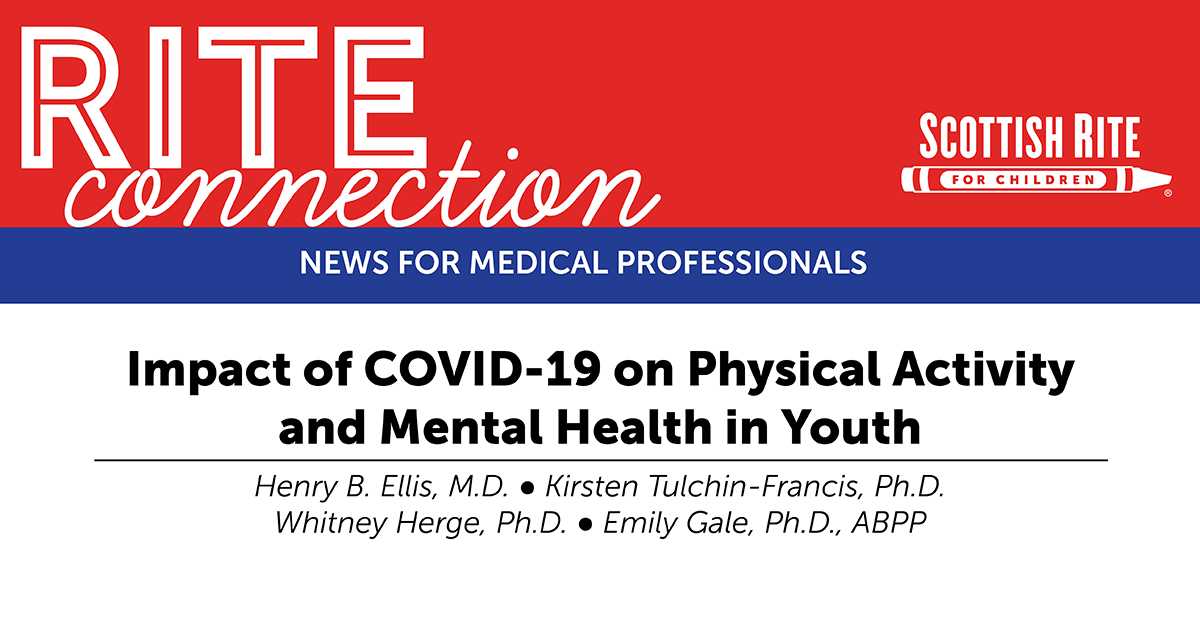
Jul 27, 2020 / Research & Innovation
Counseling Your Patients Through COVID-19
The following is a summary of a presentation on three research studies conducted at Scottish Rite regarding the physical and psychological impact of COVID-19 on youth. The lecture was given as part of the Coffee, Kids and Sports Medicine series and is available in our on-demand learning offerings.
It is well established that about one hour of physical activity each day positively impacts the physical, social and emotional well-being for children. These benefits carry into adulthood. Pediatric orthopedic surgeon Henry B. Ellis, M.D., describes that, “Kids are still developing, and you can’t put that on hold.” Early in the COVID-19 “shelter-in-place and social distancing” window, several research teams at Scottish Rite for Children recognized the potential risks to children. In each of their areas of expertise, study teams developed parent and child surveys to assess the impact of this significant lifestyle shift on physical activity and psychological well-being. This article summarizes presentations by lead investigators of three studies. Watch the recording or visit our on-demand learning page to learn more about accessing for credit.
Take-home messages:
The Impact of Social Distancing and the COVID-19 Global Pandemic on Physical Activity in American Youth
Kirsten Tulchin-Francis, Ph.D., Division Director of Movement Science
In 2019, the Movement Science team piloted a study to evaluate the exercise intensity in children at play and planned to continue this summer with collaborators from several local universities. With playgrounds and schools closed, they quickly shifted the question to –what impact do facility closures and social distancing restrictions have on the physical activity of children? To learn more, they collected parent responses representing over 1300 unique children and teens from across all 50 states.
Initial findings include:
Henry B. Ellis, M.D., pediatric orthopedic surgeon
Recognizing that kids’ work is play, whether that is sports or free play. Physical activity is positively correlated with emotional well-being and our sports medicine team wanted to evaluate the impact of the disruption of social and sport routines on young athletes.
Nearly 600 athletes shared their responses to social distancing and restrictions on group and organized sport-related activities. Participants (6 – 19 years) in this study reported an average of 7.5 years playing sports and training an average 42 weeks per year and 10 hours per week.
This high volume of training per year and hours per week can be good, assuming the athletes are playing multiple sports. The concept of sport sampling has been promoted recently with an emphasis on reduced risk of injury compared to single-sport athletes. Though athletes generally have unremarkable reports in depression and anxiety, older athletes that play only one sport had higher reports on these scores in this survey. This suggests that single-sport athletes may be less able to cope with the removal from that sport. Ellis says, “This adds to the growing evidence to encourage multi-sport participation.”
The study highlights that these athletes may not have been getting enough sleep. With a little less training and extra time, they are spending more time outside and sleeping better and a bit more. “We need to continue to find the sweet spot for sleep, free play and training schedules,” says Ellis.
Additional study findings:
TRAINING
Whitney Herge, Ph.D., and Emily Gale, Ph.D., ABPP, pediatric psychologists
Psychological studies have shown that stress and poor coping responses associated with previous health-related emergencies can have long-lasting effects. With this in mind, investigators developed a multi-stage survey to evaluate these responses over time in participants over 18 years old.
More than 1300 surveys have been completed in the first stage. Questions in this wave include demographic information about the respondent’s health, work status as well as how and how often they are accessing news regarding the pandemic. Several formal psychological tools are also used to evaluate stress and coping. Additionally, free text responses to open-ended questions are collected.
Due to the nature of the study, the results are intended to be evaluated at a later point. Investigators are interested in how coping skills might influence the trauma-related stress outcomes of participants. Additionally, coded evaluation of the free text responses will give additional insight into other factors that influence stress, i.e. financial concerns, satisfaction or dissatisfaction with government response.
It is well established that about one hour of physical activity each day positively impacts the physical, social and emotional well-being for children. These benefits carry into adulthood. Pediatric orthopedic surgeon Henry B. Ellis, M.D., describes that, “Kids are still developing, and you can’t put that on hold.” Early in the COVID-19 “shelter-in-place and social distancing” window, several research teams at Scottish Rite for Children recognized the potential risks to children. In each of their areas of expertise, study teams developed parent and child surveys to assess the impact of this significant lifestyle shift on physical activity and psychological well-being. This article summarizes presentations by lead investigators of three studies. Watch the recording or visit our on-demand learning page to learn more about accessing for credit.
Take-home messages:
- Lead by example and encourage parents to increase opportunities for moderate to vigorous activity in their families.
- Be familiar with evolving local guidelines and national resources evaluating risk and re-entry into physical activity.
- Some sports and activities have inherently higher risks of disease transmission than others.
- Deconditioning from extended periods of inactivity or rest may increase injury risk.
- Single-sport athletes may be at a higher risk of reporting depression and anxiety when removed from their sport. Encourage sport-sampling and cross training.
- Consider that device use associated with increased physical activity can bring positive effects.
- Raise awareness of improved sleep quality and quantity and encourage preservation of the improvements beyond the stay-at-home restrictions.
- Listen to subjective reports from patients and parents. Previous health-related emergencies have shown to have long-lasting effects on those with high stress and poor coping responses.
The Impact of Social Distancing and the COVID-19 Global Pandemic on Physical Activity in American Youth
Kirsten Tulchin-Francis, Ph.D., Division Director of Movement Science
In 2019, the Movement Science team piloted a study to evaluate the exercise intensity in children at play and planned to continue this summer with collaborators from several local universities. With playgrounds and schools closed, they quickly shifted the question to –what impact do facility closures and social distancing restrictions have on the physical activity of children? To learn more, they collected parent responses representing over 1300 unique children and teens from across all 50 states.
Initial findings include:
- On average, parent activity didn’t change, but their children were reported to be less active.
- The biggest decrease was in moderate to vigorous activities, which has the greatest impact on physical fitness.
- More than 50% reported getting outside and using different community resources (i.e. greenspace, trails, etc.) more frequently than they did pre-pandemic.
- Parents rated stress levels in themselves higher than perceived stress levels in their children.
Henry B. Ellis, M.D., pediatric orthopedic surgeon
Recognizing that kids’ work is play, whether that is sports or free play. Physical activity is positively correlated with emotional well-being and our sports medicine team wanted to evaluate the impact of the disruption of social and sport routines on young athletes.
Nearly 600 athletes shared their responses to social distancing and restrictions on group and organized sport-related activities. Participants (6 – 19 years) in this study reported an average of 7.5 years playing sports and training an average 42 weeks per year and 10 hours per week.
This high volume of training per year and hours per week can be good, assuming the athletes are playing multiple sports. The concept of sport sampling has been promoted recently with an emphasis on reduced risk of injury compared to single-sport athletes. Though athletes generally have unremarkable reports in depression and anxiety, older athletes that play only one sport had higher reports on these scores in this survey. This suggests that single-sport athletes may be less able to cope with the removal from that sport. Ellis says, “This adds to the growing evidence to encourage multi-sport participation.”
The study highlights that these athletes may not have been getting enough sleep. With a little less training and extra time, they are spending more time outside and sleeping better and a bit more. “We need to continue to find the sweet spot for sleep, free play and training schedules,” says Ellis.
Additional study findings:
TRAINING
- 9 in 10 continued training independently.
- 7 in 10 remained in regular contact with team.
- 4 in 10 used a virtual platform to train as a team.
- Reduced weekly average training hours from 10 to <7.
- 1 in 2 spent more time outdoors.
- 3 in 10 reported improved quality of sleep.
- >1 hour more sleep per night.
- 1 in 10 reported changes to their goals or aspirations.
- 1 in 4 reported higher depression scores.
Whitney Herge, Ph.D., and Emily Gale, Ph.D., ABPP, pediatric psychologists
Psychological studies have shown that stress and poor coping responses associated with previous health-related emergencies can have long-lasting effects. With this in mind, investigators developed a multi-stage survey to evaluate these responses over time in participants over 18 years old.
More than 1300 surveys have been completed in the first stage. Questions in this wave include demographic information about the respondent’s health, work status as well as how and how often they are accessing news regarding the pandemic. Several formal psychological tools are also used to evaluate stress and coping. Additionally, free text responses to open-ended questions are collected.
Due to the nature of the study, the results are intended to be evaluated at a later point. Investigators are interested in how coping skills might influence the trauma-related stress outcomes of participants. Additionally, coded evaluation of the free text responses will give additional insight into other factors that influence stress, i.e. financial concerns, satisfaction or dissatisfaction with government response.



